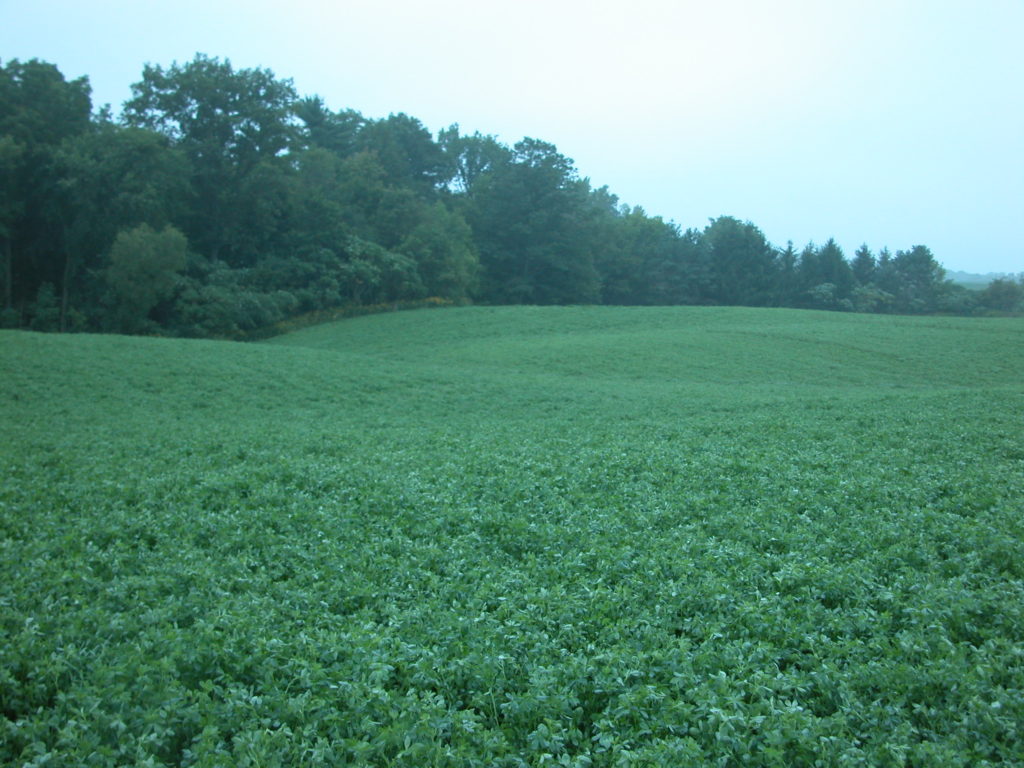Scouting is an important part of growing quality forage. Just like other field crops, scouting alfalfa helps growers stay ahead of emerging problems, correctly time harvests, and make better decisions when planning future crops.
Plant counts should be done spring and fall (Table 1). These can be done when the alfalfa is dormant. The spring count is a good time to dig up some plants and assess root health. Stem counts are useful for predicting yield potential, and these should be done in spring when there is 15-20cm (6-8”) of growth (Table 2). If the number of plants or stems per square foot is too low, consider over-seeding with grasses to improve yields or rotating that field out of alfalfa.
Table 1. Assessing alfalfa stands using the plant count method
| Age of Alfalfa Stand | Desired plant count per square foot |
| New Seeding | 20+ plants |
| Year 1 | 12 to 20 plants |
| Year 2 | 8 to 12 plants |
| Year 3 | 5 plants |
Table 2. Assessing alfalfa stands using the stem count method
| Stems per square foot | % of Maximum Yield |
| 55 or more | 100% |
| 40 to 50 | 75 to 92% |
| Less than 40 | Stand is too weak to keep |
Scout alfalfa fields weekly from when the crop breaks dormancy until after the last harvest of the year. Walk the field in a zig-zag or “W” pattern, and take a different route each week to observe more of the field over the growing season.
Alfalfa development is predicted using Base 5°C Growing Degree Days (GDD). To calculate GDD:
- Add the daily maximum and minimum temperatures together.
- Divide by 2 to get an average daily temperature.
- Subtract 5 from your daily average to get the daily accumulation of growing degrees. If the answer is negative, assume it is 0.
- Add the daily accumulation to a running total for the season.
Take care when referencing alfalfa GDD information from the United States; their GDDs are in degrees Fahrenheit, which change the reference numbers for alfalfa staging. To convert to Base 5°C: divide the Base 42°F GDD by 9, and then multiply by 5.
I prefer CHUs, why can’t I use them on alfalfa? The Ontario Crop Heat Unit (CHU) system was designed to predict corn development. Corn is a warm-season grass, and its development occurs at relatively high temperatures. Soybean growers are often able to use CHUs because soybeans are a warm-season legume, and use the same photosynthetic process as corn to produce sugar. Alfalfa is a cool-season crop; it uses a different photosynthetic pathway than corn and soybeans, and has different temperature tolerances. This is why Base 5°C GDD is a more accurate method of estimating crop stage for alfalfa.
Alfalfa generally does not grow until it receives at least 110 GDDs. For maximum (dairy) quality, first-cut alfalfa should be harvested at 390 GDD, before 10% bloom. Waiting will increase yields, but feed value starts to decline.
The Forage Scouting Calendar (Figure 1) is a guideline to insect, pest, and disease activity in alfalfa in southern and eastern Ontario. Crops pressured by insects, pests, and diseases have less vigour and anything that affects alfalfa leaves can reduce yield and feed value. OMAFRA’s Publication 811: Agronomy Guide for Field Crops describes scouting techniques for different forage pests starting on page 336. Some pest development is also modelled using GDD; however those models may use a different temperature base. For example, alfalfa weevil development is estimated on a Base 9°C GDD model, so the number of GDDs at a location on the same date will differ than those given for alfalfa (Base 5).

The goal of weed control in alfalfa is to increase both the quantity and quality of feed. New seedings are most sensitive to competition from weeds; however, identifying weed pressures in an old stand can influence the next crop in the rotation. Chemical weed control is most effective in spring or fall.
To reduce the risk of winter injury in alfalfa, plants need 500 GDDs between the final harvest and the first killing frost. This gives the alfalfa time to build root reserves that will carry it through the winter and allow for rapid green-up and growth the following spring. In situations where forage supplies are tight, a final cut could be taken with less than 200 GDDs remaining in the season, as the alfalfa will not be able to regrow before the frost.
